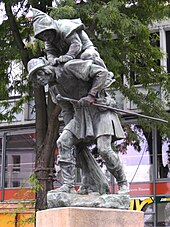Huckup (Hildesheim)
The Huckup is a memorial created by the Dresden sculptor Carl Röder in 1905 on the corner of Schuhstrasse and Hoher Weg, i.e. at the southern end of the pedestrian zone in Hildesheim . It illustrates the old Hildesheim legends of the Huckup (High German: "Hock-auf"). Karl Seifart handed down a Huckup saga for Hildesheim from the Ziegenberg near Söhre and a second about a Huckup in the Itzumer Holze. The motif of the stool , which according to folklore research is related to the idea of the revenant , is rationally reinterpreted by the sculptor or by the inscription on the base of the monument in the sense of bourgeois morality. In the statement of the monument, the uncanny elemental being, the stool, becomes a goblin who - embodying the guilty conscience - jumps on thieves' backs. In the representation, which is supposed to serve as a warning to all thieves, a juvenile apple thief is the one who is visited in this way.
The inscription on the base, written in Hildesheimer Platt , reads:
-
Boy, lat dei Appels stahn
-
Sweet packet deck dei Huckup.
-
The Huckup is a strong bug
- Do evil judgment with dei Stehldeifs.
Web links
Individual evidence
- ↑ Karl Seifart: Legends, fairy tales, tales and customs from the city and monastery of Hildesheim. Göttingen 1854, p. 6 ff.
Coordinates: 52 ° 9 '3.67 " N , 9 ° 57' 3.1" E

